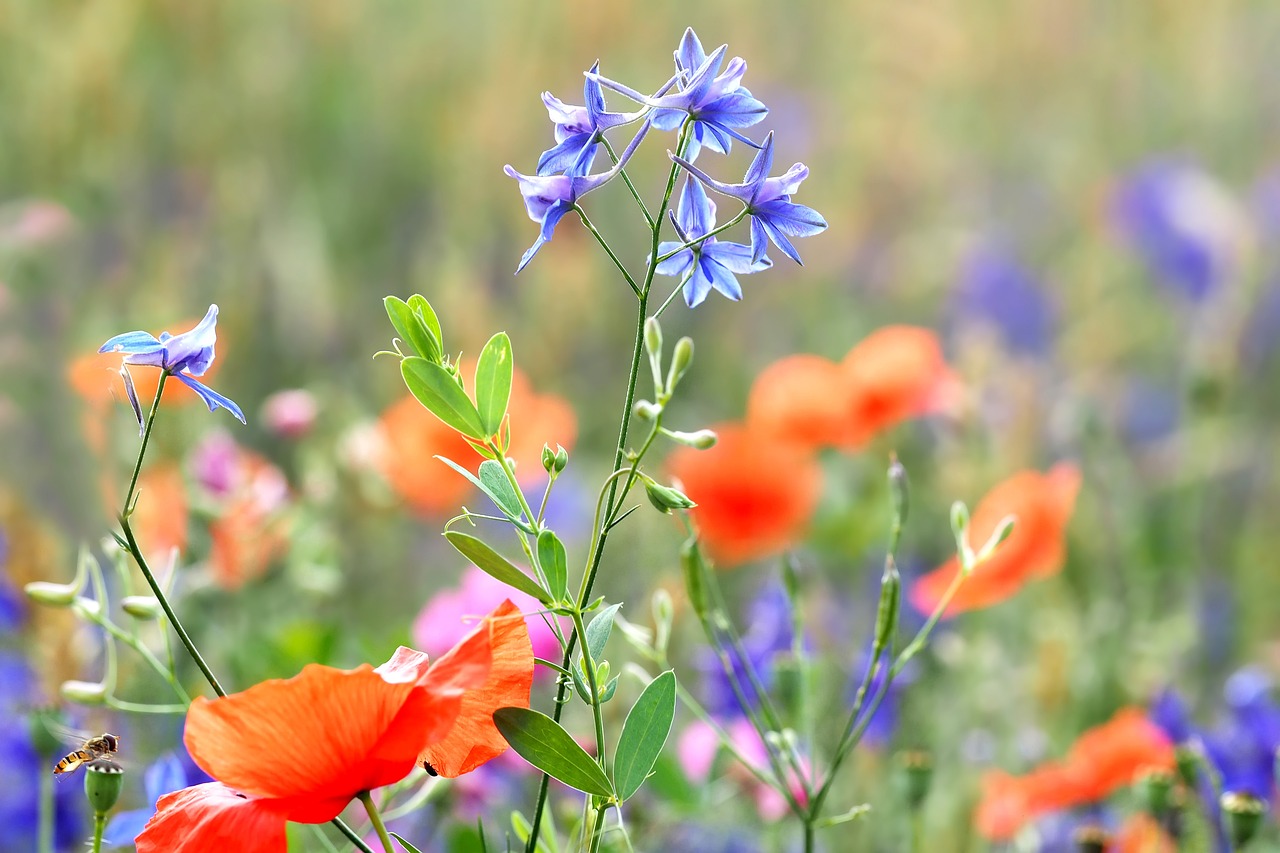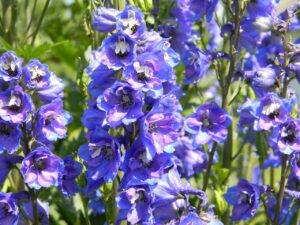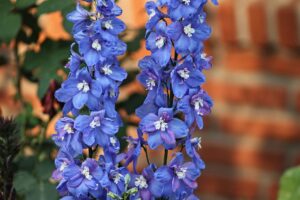Delphinium
Overview
Delphinium, also known as larkspur, is a vibrant-hued plant prized for its striking appearance and towering height. Boasting over 300 species, it fits beautifully into ornamental gardens where it lures hummingbirds and captivates onlookers, although it carries a toxic trait that requires cautious handling.

Characteristics
Known for its vivid colors, diverse species, and tall, dramatic spikes that attract hummingbirds and beautify garden landscapes.
Region
Native to the Northern Hemisphere and adaptable to a wide range of climates.
Natural Habitat
Delphinium is usually found in the wild on mountain slopes, forest clearings, and riverbank areas.
Cultivation
Full sun, moderate water, and well-draining soil with a neutral to slightly alkaline pH.
Uses and Benefits
Delphiniums, with their rich hues and majestic spikes, are more than just a feast for the eyes. They play a significant role in bringing a burst of color to gardens and elevate the aesthetic of larger floral designs. Not only do they dazzle onlookers, but they also invite the delightful hum of birds; hummingbirds, in particular, are drawn to delphiniums like magnets, creating a lively and dynamic garden space5.
While mainly ornamental, remember that the beauty of these towering flowers comes with a caution—delphiniums contain toxic properties, necessitating responsible cultivation away from curious pets and children3.

Cultivation Tips
To cultivate a thriving delphinium plant, start by choosing a spot in your garden that has well-drained soil and receives full sun to partial shade. Ensure that the location is sheltered from strong winds to protect the tall stalks. It’s essential to enrich the soil with compost or aged manure before planting, creating a nourishing foundation for your delphiniums.
Regular watering is a must, but take care not to let water linger at the roots—delphiniums do not enjoy soggy feet. Support their lofty growth with stakes or a cage, and remember that these beauties will benefit from a layer of mulch to keep their roots cool and moist. For continual blooms, deadhead spent flowers to encourage new growth and consider dividing the plants every 3 to 4 years to maintain their vigor2 3.
Lastly, with their love for cool springs, it’s best to add these plants to your garden early in the planting season to enjoy their full blooming potential3.
Seasonal Considerations
Delphiniums shine their brightest when their seasonal requirements are taken into account. With a natural lifespan of three to five years, their vibrant blooms appear from late spring into early summer. Depending on the variety, these florid displays may last right through the growing season, offering a prolonged period of enjoyment.3 For those eager to see these stately spires grace their garden yearly, it’s key to remember that delphiniums thrive during cool, extended springs. This backdrop of milder weather allows them to dazzle gardeners and onlookers with a cascade of color that catches the eye and captivates the heart.
Whether as a beacon for hummingbirds or as a stately feature in your floral ensemble, understanding and accommodating their seasonal needs is pivotal for peak performance.

Issues and Troubleshooting
Delphiniums, with their towering spires of color, surely capture the heart, but they can be a little finicky, clamoring for some special attention when it comes to their care. One of the hurdles you might stumble upon is their susceptibility to fungal diseases—particularly powdery mildew and crown rot, which thrive in humid conditions. To keep your blooms healthy, ensure good air circulation around the plants and consider using a fungicide if problems persist3.
Another bump in the road could be pests like slugs and snails, which are quite fond of tender delphinium leaves. Sprinkling diatomaceous earth around the base of your plants or setting up slug traps can help keep these critters at bay4. And let’s not forget the stately stalks can sometimes get a bit lofty and might require staking to prevent them from toppling over in windy weather2.
Remember, while delphiniums are a feast for the eyes with their rich blues and purples, they are no treat for the tummy. Their alluring petals mask a toxic nature that is harmful if ingested, so it’s pivotal to exercise caution and place them away from children and pets3. Despite these challenges, with a touch of vigilance and care, delphiniums can be the crowning glory of your garden spectacle.
History and Folklore
The Delphinium, with its alluring spikes of colorful blooms, carries a tapestry of stories and symbolism through the ages. Historically, these enchanting flowers, also known as larkspur, were entwined with many tales and traditions. In Greek mythology, they are linked to the tragic story of the warrior Ajax; it is said delphiniums sprouted from his blood as he fell on his sword, the petals inscribed with a message of regret1.
Ancient peoples held the plant in high regard, often attributing magical properties to it. For instance, it was believed that the delphinium had the power to protect against scorpions’ stings and during the Middle Ages, it was used in a concoction called ‘Witches’ Flying Ointment’ for its hallucinogenic effects1. Folklore also suggests that wearing the flower was thought to protect from ghosts and evil spirits, and the delphinium’s name itself is derived from the Greek word “delphis,” meaning dolphin, reportedly for the shape of the nectary.
As you delve into the lush blue and purple hues of this storied bloom, imagine the whispers of ancient lore that accompany each petal and stem, and how these majestic flowers have captured hearts and imaginations through time.
References
1. Delphinium (Larkspur): Plant Care and Growing Guide – Gardenia, https://www.gardenia.net/guide/learn-how-to-plant-and-care-for-your-delphiniums
2. In-Depth Techniques You Need for Growing Delphinium – Team Flower Blog, https://education.teamflower.org/learn/growing/ssl/in-depth-techniques-you-need-for-growing-delphinium
3. How to Grow and Care for Delphinium – The Spruce, https://www.thespruce.com/delphinium-care-guide-7105084
4. Delphiniums: How to Plant, Grow, and Care for Delphinium Flowers | The Almanac, https://www.almanac.com/plant/delphiniums
5. How to Plant, Grow and Care for Delphinium – HGTV, https://www.hgtv.com/outdoors/flowers-and-plants/how-to-plant-grow-and-care-for-delphinium
Image Credit: kie-ker
Image Credit: AKuptsova
Image Credit: manfredrichter
Nicolas Duval
Nicolas is a passionate advocate for nature and the art of wildcrafting. His dedication shines through in Wildcraftia, a website he meticulously crafted to serve as a haven for nature enthusiasts worldwide. Driven by a deep appreciation for nature’s connection to humanity, Nicolas embarked on his journey in 2011 with SmokableHerbs, a platform showcasing his love for nature’s bounty. Building upon this foundation, he established Smokably, a thriving online store offering premium herbs and blends to a global audience.
